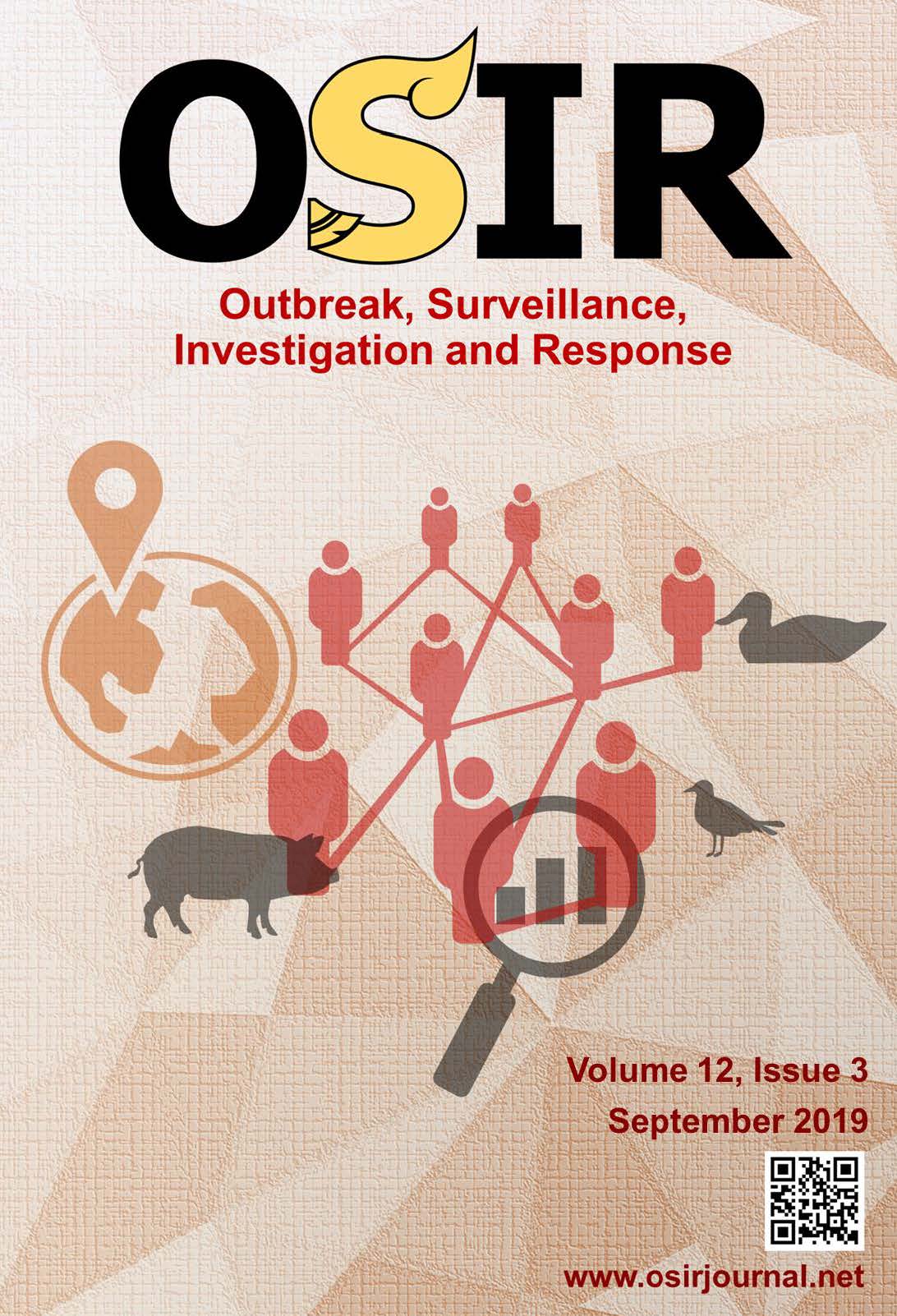Epidemiological Trends of Malaria in Eastern Shan State, Myanmar 2000-2016
DOI:
https://doi.org/10.59096/osir.v12i3.262938Keywords:
malaria, morbidity, mortality, annual blood examination rate, Eastern Shan State, MyanmarAbstract
Malaria is a priority communicable disease in Eastern Shan State (ESS) of Myanmar. This study aimed to describe the malaria situation, epidemiology and treatment services in ESS during 2000-2016. Data from township malaria monthly reports in ESS during 2000-2016 were analyzed by time, place, person, species and treatment services. Malaria morbidity, mortality and case-fatality rate decreased from 25.0 to 3.7 per 1,000 population, 15.0 to 0.2 per 100,000 population and 4.6% to 1.3%, respectively, during 2000-2016. The male to female ratio was 3:2 and those over 15 years old constituted 60% of all cases. The number of cases declined by 88% and 99% among those younger than 5 years of age and pregnant women, respectively. During 2011-2016, the case detection rate increased from 2% to 12%, and 94% of blood examinations used a rapid diagnostic test. Plasmodium vivax (63%) was the most prevalent parasite species, followed by Plasmodium falciparum (33%) while mixed parasites accounted for 4% of all infections. Non-government-controlled areas contributed more than 80% of cases between 2013 and 2016. Remarkable reductions in malaria morbidity and mortality in ESS followed improvements in early detection, appropriate treatment and effective vector control. However, the overwhelming contribution on caseload in non-government-controlled areas remain a challenge for the elimination of malaria in Myanmar.
References
World Health Organization. Strategy in malaria elimination in Greater Mekong Subregion (2015 – 2030). Geneva: World Health Organization; 2015.
Department of Public Health, Myanmar Ministry of Health and Sports. National strategic plan; intensifying malaria control and accelerating progress towards malaria elimination (2016-2020). Nay Pyi Taw: Myanmar Ministry of Health and Sports; 2017.
Eastern Shan State Vector Borne Diseases Control Programme, Eastern Shan State Public Health Department. VBDC annual reports, 2000-2016. Keng Tung: Eastern Shan State Public Health Department; 2016.
National Malaria Control Programme, Department of Public Health. Annual VBDC report 2015. Nay Pyi Taw: Ministry of Health and Sports; 2015.
Department of Population, Myanmar Ministry of Immigration and Population. Eastern Shan State census report, 2014. Nay Pyi Taw: Myanmar Ministry of Immigration and Population; 2015.
Department of Public Health, Myanmar Ministry of Health and Sports. Monitoring and Evaluation Plan (2016-2020); National Malaria Control Programme. Nay Pyi Taw: Myanmar Ministry of Health and Sports;2017.
Okiro EA, Alegana VA, Noor AM, Snow RW. Changing malaria intervention coverage, transmission and hospitalization in Kenya. Malar J. 2010 Dec 15;9(1):285.
Taffese HS, Hemming-Schroeder E, Koepfli C, Tesfaye G, Lee M, Kazura J, et al. Malaria epidemiology and interventions in Ethiopia from 2001 to 2016. Infect Dis Poverty. 2018 Dec 5;7(1):103.
World Health Organization. Impact of longlasting insecticidal-treated nets (LLINs) and artemisinin-based combination therapies (ACTs) measured using surveillance data, in four African countries. Geneva: World Health Organization Global Malaria Programme;2008.
Pasquale H, Jarvese M, Julla A, Doggale C, Sebit B, Lual MY, et al. Malaria control in South Sudan, 2006–2013: strategies, progress and challenges. Malar J. 2013 Oct 27;12(1):374.
Pindolia DK, Garcia AJ, Huang Z, Smith DL, Alegana VA, Noor AM, et al. The demographics of human and malaria movement and migration patterns in East Africa. Malar J. 2013 Nov 5; 12:397
Khine SK, Swaddiwudhipong W, Lwin NN, Timasarn K, Hlaing T. Epidemiological situation of malaria in Rakhine State, Myanmar during 2000-2014. OSIR. 2017 Sep;10(3):16-21.
Otte im Kampe E, Müller O, Sie A, Becher H. Seasonal and temporal trends in all-cause and malaria mortality in rural Burkina Faso, 1998–2007. Malar J. 2015 Dec 5;14(1):300.
World Health Organization. World malaria report 2016. Geneva: World Health Organization; 2016. Licence: CC BY-NC-SA3.0 IGO.
Downloads
Published
How to Cite
Issue
Section
License
Copyright (c) 2023 Outbreak, Surveillance, Investigation & Response (OSIR) Journal

This work is licensed under a Creative Commons Attribution-NonCommercial-NoDerivatives 4.0 International License.








